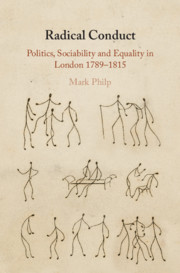Book contents
- Radical Conduct
- Radical Conduct
- Copyright page
- Dedication
- Contents
- Figures and Tables
- Acknowledgements
- Introduction
- 1 Politics and Privacy
- 2 Disagreement and Deliberation
- 3 Plurality
- 4 Radical Literary Women
- 5 Gender and Deliberative Equality
- 6 Negotiating Equality
- 7 A Private Affair
- 8 Music and Movement
- Conclusion
- Bibliography
- Index
3 - Plurality
Women’s Circles in London
Published online by Cambridge University Press: 20 August 2020
- Radical Conduct
- Radical Conduct
- Copyright page
- Dedication
- Contents
- Figures and Tables
- Acknowledgements
- Introduction
- 1 Politics and Privacy
- 2 Disagreement and Deliberation
- 3 Plurality
- 4 Radical Literary Women
- 5 Gender and Deliberative Equality
- 6 Negotiating Equality
- 7 A Private Affair
- 8 Music and Movement
- Conclusion
- Bibliography
- Index
Summary
While commentators tend to assume a single public culture, this chapter begins to develop an argument for a more fragmentary London world, in which there are many relatively small sets and circles, which provide many people, especially women, with the core of their social life.Close examination of the diaries of Marianne Ayrton and Eliza Soane allows us to see how very bounded women’s sociability and intimacies often were in practice. The chapter compares male and female experience and the relatively more open character of male expectations, in contrast to a female world where contacts were often very more rigorously policed.Using a range of diary sources it is possible to see that many women were rooted in ‘little platoons’ dominated by family and the business concerns of their husbands, while men were less socially constrained.Nonetheless, the chapter lays the ground for questioning how far the repression of the 1790s might have had differential effects, forcing men to question the reliability of their wider acquaintance.
- Type
- Chapter
- Information
- Radical ConductPolitics, Sociability and Equality in London 1789-1815, pp. 93 - 122Publisher: Cambridge University PressPrint publication year: 2020

